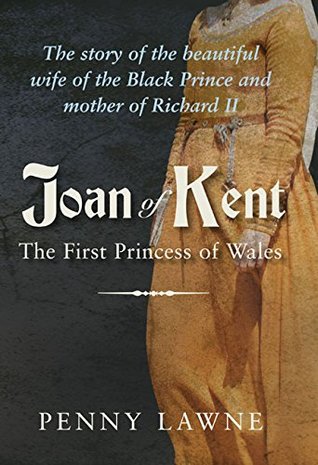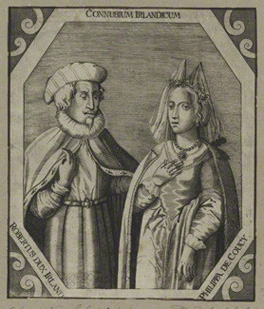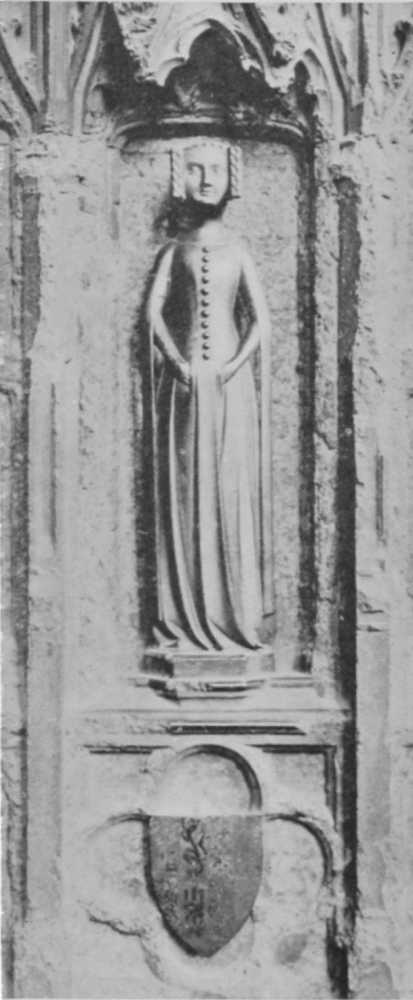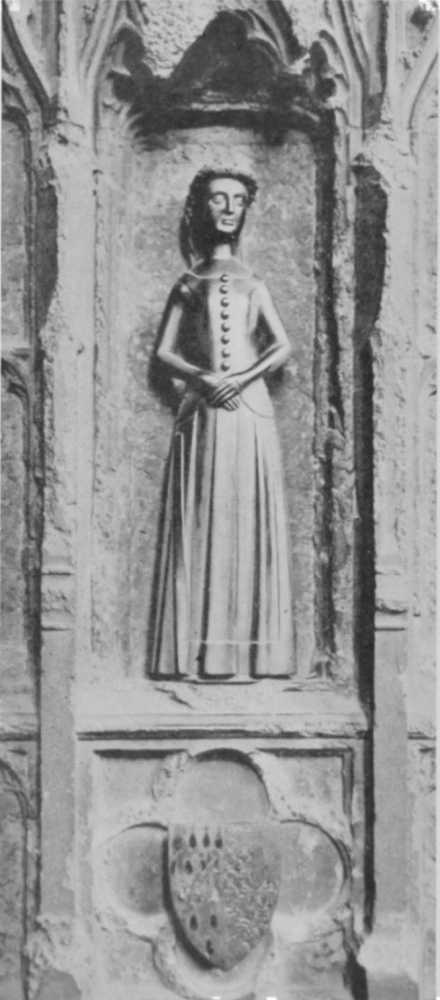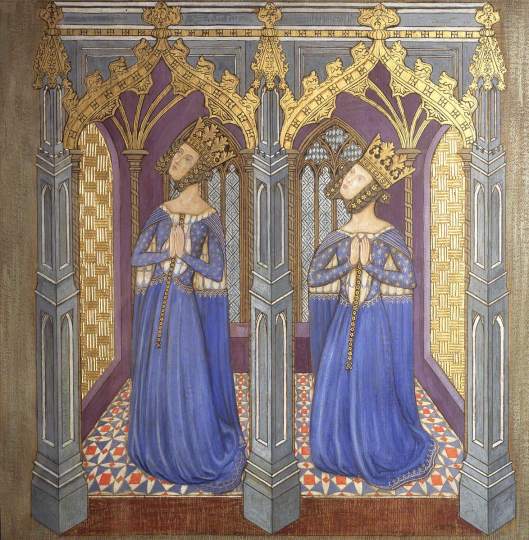
This image depicts Philippa of Hainault and one of her daughters, probably Isabella, from the wall painting of St Stephen’s Chapel. Reconstructed by Ernest William Tristram. Parliamentary Art Collection
Isabella (1332-1379/82)
-
Also known as: Isabella de Coucy, Countess of Bedford, Isabel of Woodstock
-
Parents: Edward III of England and Philippa of Hainault
-
Spouse: Enguerrand de Coucy
-
Offspring:
-
Mary, Countess of Soissons
-
Phillippa de Vere, Duchess of Ireland
Isabella was the eldest daughter and second child of Philippa of Hainault and the English king Edward III. Philippa and Edward had at least twelve or thirteen children altogether, the most of any English queen apart from Eleanor of Castile, who produced sixteen. A number of these children died very young, with only eight surviving long enough to become betrothed or married. Four of these were daughters, Isabella, Joan, Mary, and Margaret.
The first of these, Isabella, was the longest lived and the only daughter to have children. Isabella was Edward and Philippa’s second child after their eldest son, Edward, the Prince of Wales, who died before his father and thus never became king. Isabella was probably named after her paternal grandmother, Isabella of France, who as the wife and associate in the deposition of Edward II had a rather salacious reputation and an uncertain relationship with her own son, Edward III. This follows something of a naming tradition within the royal family, as the firstborn daughters of several kings were named after the preceding queen: Edward I’s daughter Eleanor took the name of his mother, Eleanor of Provence, as did Edward II’s after his own mother Eleanor of Castile.
In 1340, Isabella and Joan joined their mother in following Edward to the Low Countries for the war he was waging. When they were sent back to England for their safety, a household was set up for Isabella, Joan, Lionel, and John, lasting for about two years, an unusual arrangement, as usually the royal children after the eldest son shared their mother’s household. Records for this household indicate that Isabella had three damsels to attend her, in addition to sharing two damsels of the chamber with her sister Joan, as well as a shared esquire and one of her own, and the queen assigned another to her, named Esmon de Ekeney. All the princes and princesses also had pages. Isabella also had three tailors.
The unmarried Isabella was later provided with a household and independent lands in the 1350s.
Marriage Negotiations
Isabella is popularly believed to have been her father’s favourite daughter, which may have been partly why he allowed Isabella to be picky about her choice of future husband. Born in 1332, Isabella’s first marital prospects emerged at the age of three with Pedro, the heir to the throne of Castile, but Isabella’s younger sister Joan took her place.
Five years later, the next match proposed was with Louis, the son of the count of Flanders, but the negotiations fell through as the English supported a rebellion against the Count. This alliance was revisited, during the request for a papal dispensation for Isabella to marry the Duke of Brabant, but Louis, who had now inherited the title, married Marguerite de Brabant despite his promise to Isabella, after nine years of prevarication. Charles IV of Bohemia was also suggested. Richard II, Edward III’s successor and grandson through Edward, Prince of Wales, would later marry Anne of Bohemia, the daughter of Charles IV.
As time passed, Isabella’s suitors became less illustrious. In 1359, with Isabella now at the ripe age of nineteen, Edward III arranged her marriage with Bernard, the son of one of his supporters from Gascony named Bernard Ezi, the sieur d’Albret. However, Isabella refused at the last moment before boarding the ship that was to take her to her new husband. Her father showed no sign of annoyance, perhaps because the match offered no particular benefits, especially after the possibilities of the throne of Castile and the trading possibilities with Flanders. Instead Isabella was awarded the £1000 promised if the marriage failed to proceed and over time acquired significant lands of her own in England.
Multiple failed engagements were typical for daughters of high status in the medieval period and no reflection on Isabella’s attractiveness or her own wishes. Medieval marriages, particularly those of high status, were arranged chiefly for political benefit. In this case, Edward III also had multiple more offspring to use as political pawns. Although all of the possibilities had been led with an eye to the Hundred Years’ War between England and France, their failure ultimately had little effect.
Enguerrand de Coucy
Isabella eventually married at the age of thirty-three, unusually late for a medieval woman of high status. The chosen man was Enguerrand (or Ingelram/Ingram) de Coucy, about eight years her junior, a French hostage who had won Edward III’s favour to the extent that the king granted Enguerrand both English lands and the earldom of Bedford. Enguerrand also had loftier goals, pursuing his claim to his grandfather’s lands on the continent.
The marriage is popularly believed to have been at least partly a love match. However, far from disappointment at de Coucy’s lower status, Edward III may have actually encouraged if not suggested the match, as bringing in one the enemy’s supporter to his own fold was a major coup. Isabella enjoyed a lavish wedding, as was typical for the king’s eldest daughter, including gifts of gold crowns for the couple.
Isabella’s reluctance to marry may have stemmed from her spoilt childhood, or her unusually close relationship with her family, as she continued visiting England and the royal court frequently after her marriage.
Although for a time Enguerrand gave his allegiance to the Pope rather than to the English or French kings, eventually he returned to serving France again. This necessitated the forfeiture of the couple’s lands in England, although these were regranted to Isabella with the proviso that she remain in England. Later Isabella entered into a dispute over some of her lands with Alice Perrers, a prominent mistress of Edward III.
The couple’s younger daughter, Mary, stayed in England with Isabella, and their other child, Philippa, in France with her father.
Isabella had already been made a member of the Order of the Garter, created by her father Edward III, in 1376, and again after the departure of Enguerrand in 1379, the only female so honoured aside from her mother during the reign of Edward III.
Scholars differ over the exact date of Isabella’s death, but it was probably between the year 1379 and 1382.
Two contemporary statues of Isabella have since been destroyed, and the reconstructed image of the wall painting of St Stephen’s Chapel is no indication of what Isabella may have really looked like, simply based on contemporary ideals of beauty.
Next post: The Daughters of Philippa of Hainault
Sources and Further Reading
Joseph Bain, ‘Petition by the Lady Isabella, Countess of Bedford, temp. Richard II’, Archaeological Journal 36 (1879), pp. 174-176.
James L. Gillespie, ‘Isabella, countess of Bedford (1332-1379)‘, Oxford Dictionary of National Biography, 2004.
Jessica Lutkin, ‘Isabella de Coucy: The Exception Who Proves the Rule’, in Chris Given-Wilson (ed.), Fourteenth Century VI (Woodbridge, 2010), pp. 130-148.
W. M. Ormrod, ‘Edward III and His Family‘, Journal of British Studies 26, 4 (1987), pp. 398-422.
W. M. Ormrod, ‘The Royal Nursery: A Household for the Younger Children of Edward III’, The English Historical Review 120, 486 (2005), pp. 398-415.
Archival Documents:
E 30/1642 Promise by Louis, Count of Flanders, to marry Isabel daughter of Edward III. Dunkirk.
PHC/23 Settlement for the marriage of Isabella, daughter of Edward III, with Louis, Count of Flanders
SC 1/40/5 Isabella of Woodstock and Joan of the Tower, daughters of Edward III, to John de Offord, dean of Lincoln, chancellor: request for the discharge of taxation upon men who have performed their service. Dated at Fulham.
SC 8/41/2011 Petition by Isabel of Woodstock, Countess of Bedford
SC 8/95/4710 Isabella, Countess of Bedford, asks the King to give all the lordships, lands, tenements and other possessions taken into his hand when her husband, the Lord de Coucy, surrendered his homage to him, to certain friends of hers, to hold for term of life or according to the terms of the charters and letters patent she had for them, for her benefit.
